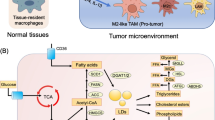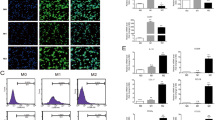Abstract
Background
Tumor-associated macrophages (TAMs) constitute the main infiltrating immune cells in the solid tumor microenvironment. Amounting studies have analyzed the antitumor effect on immune response induced by Toll-like receptor (TLR) agonists, such as lipopolysaccharide (LPS), γ-interferon (γ-IFN), and palmitic Acid (PA). However, their combined treatment for gastric cancer (GC) has not been illuminated.
Methods
We investigated the relevance of macrophage polarization and the effect of PA and γ-IFN in GC in vitro and in vivo. M1 and M2 macrophage-associated markers were measured by real-time quantitative PCR and flow cytometry, and the activation level of the TLR4 signaling pathways was evaluated by western blot analysis. The effect of PA and γ-IFN on the proliferation, migration, and invasion of GC cells (GCCs) was evaluated by Cell-Counting Kit-8, transwell assays, and wound-healing assays. In vivo animal models were used to verify the effect of PA and γ-IFN on tumor progression, and the M1 and M2 macrophage markers, CD8 + T lymphocytes, regulatory T cells (Treg) cells, and the myeloid-derived suppressor cells (MDSCs) in tumor tissues were analyzed by flow cytometry and immunohistochemical (IHC).
Results
The results showed that this combination strategy enhanced M1-like macrophages and diminished M2-like macrophages through the TLR4 signaling pathway in vitro. In addition, the combination strategy impairs the proliferative and migratory activity of GCC in vitro and in vivo. While, the antitumor effect was abolished using the TAK-424 (a specific TLR-4 signaling pathway inhibitor) in vitro.
Conclusions
The combined treatment of PA and γ-IFN inhibited GC progression by modulating macrophages polarization via the TLR4 pathway.






Similar content being viewed by others
Availability of data and materials
Not applicable.
References
Adams S (2009) Toll-like receptor agonists in cancer therapy. Immunotherapy 1:949–964. https://doi.org/10.2217/imt.09.70
Anfray C et al (2021) Intratumoral combination therapy with poly(I:C) and resiquimod synergistically triggers tumor-associated macrophages for effective systemic antitumoral immunity. J Immunother Cancer. https://doi.org/10.1136/jitc-2021-002408
Arwert EN, Harney AS, Entenberg D, Wang Y, Sahai E, Pollard JW, Condeelis JS (2018) A unidirectional transition from migratory to perivascular macrophage is required for tumor cell intravasation. Cell Rep 23:1239–1248. https://doi.org/10.1016/j.celrep.2018.04.007
Bejarano L, Jordāo MJC, Joyce JA (2021) Therapeutic targeting of the tumor microenvironment. Cancer Discov 11:933–959. https://doi.org/10.1158/2159-8290.Cd-20-1808
Boehm U, Klamp T, Groot M, Howard JC (1997) Cellular responses to interferon-gamma. Annu Rev Immunol 15:749–795. https://doi.org/10.1146/annurev.immunol.15.1.749
Boulter L et al (2012) Macrophage-derived Wnt opposes Notch signaling to specify hepatic progenitor cell fate in chronic liver disease. Nat Med 18:572–579. https://doi.org/10.1038/nm.2667
Boutilier AJ, Elsawa SF (2021) Macrophage polarization states in the tumor microenvironment. Int J Mol Sci. https://doi.org/10.3390/ijms22136995
Burke JD, Young HA (2019) IFN-γ: A cytokine at the right time, is in the right place. Semin Immunol 43:101280. https://doi.org/10.1016/j.smim.2019.05.002
Calabrese V, Cighetti R, Peri F (2015) Molecular simplification of lipid A structure: TLR4-modulating cationic and anionic amphiphiles. Mol Immunol 63:153–161. https://doi.org/10.1016/j.molimm.2014.05.011
Cao M et al (2019) Ginseng-derived nanoparticles alter macrophage polarization to inhibit melanoma growth. J Immunother Cancer 7:326. https://doi.org/10.1186/s40425-019-0817-4
Carta G, Murru E, Banni S, Manca C (2017) Palmitic acid: physiological role, metabolism and nutritional implications. Front Physiol 8:902. https://doi.org/10.3389/fphys.2017.00902
de Araujo Junior RF, Eich C, Jorquera C, Schomann T, Baldazzi F, Chan AB, Cruz LJ (2020) Ceramide and palmitic acid inhibit macrophage-mediated epithelial-mesenchymal transition in colorectal cancer. Mol Cell Biochem 468:153–168. https://doi.org/10.1007/s11010-020-03719-5
DeNardo DG, Ruffell B (2019) Macrophages as regulators of tumour immunity and immunotherapy. Nat Rev Immunol 19:369–382. https://doi.org/10.1038/s41577-019-0127-6
Deng Y et al (2021) Sphingomyelin synthase 2 facilitates M2-like macrophage polarization and tumor progression in a mouse model of triple-negative breast cancer. Acta Pharmacol Sin 42:149–159. https://doi.org/10.1038/s41401-020-0419-1
Dong L et al (2021) The loss of RNA N(6)-adenosine methyltransferase Mettl14 in tumor-associated macrophages promotes CD8(+) T cell dysfunction and tumor growth. Cancer Cell 39:945-957.e910. https://doi.org/10.1016/j.ccell.2021.04.016
Fatima S et al (2019) Palmitic acid is an intracellular signaling molecule involved in disease development. Cell Mol Life Sci 76:2547–2557. https://doi.org/10.1007/s00018-019-03092-7
Freitas MS, Oliveira AF, da Silva TA, Fernandes FF, Gonçales RA, Almeida F, Roque-Barreira MC (2016) Paracoccin induces M1 polarization of macrophages via interaction with TLR4. Front Microbiol 7:1003. https://doi.org/10.3389/fmicb.2016.01003
Geeraerts X, Bolli E, Fendt SM, Van Ginderachter JA (2017) Macrophage metabolism as therapeutic target for cancer, atherosclerosis, and obesity. Front Immunol 8:289. https://doi.org/10.3389/fimmu.2017.00289
Greten FR, Grivennikov SI (2019) Inflammation and cancer: triggers, mechanisms, and consequences. Immunity 51:27–41. https://doi.org/10.1016/j.immuni.2019.06.025
Hinshaw DC, Shevde LA (2019) The tumor microenvironment innately modulates cancer progression. Cancer Res 79:4557–4566. https://doi.org/10.1158/0008-5472.Can-18-3962
Huang S et al (2012) Saturated fatty acids activate TLR-mediated proinflammatory signaling pathways. J Lipid Res 53:2002–2013. https://doi.org/10.1194/jlr.D029546
Huang L, Xu H, Peng G (2018) TLR-mediated metabolic reprogramming in the tumor microenvironment: potential novel strategies for cancer immunotherapy. Cell Mol Immunol 15:428–437. https://doi.org/10.1038/cmi.2018.4
Huang S et al (2021) Identification and validation of plasma metabolomic signatures in precancerous gastric lesions that progress to cancer. JAMA Netw Open 4:e2114186. https://doi.org/10.1001/jamanetworkopen.2021.14186
Karki K, Pande D, Negi R, Khanna S, Khanna RS, Khanna HD (2015) Correlation of serum toll like receptor 9 and trace elements with lipid peroxidation in the patients of breast diseases. J Trace Elem Med Biol 30:11–16. https://doi.org/10.1016/j.jtemb.2014.12.003
Kawasaki T, Kawai T (2014) Toll-like receptor signaling pathways. Front Immunol 5:461. https://doi.org/10.3389/fimmu.2014.00461
Kelly B, O’Neill LA (2015) Metabolic reprogramming in macrophages and dendritic cells in innate immunity. Cell Res 25:771–784. https://doi.org/10.1038/cr.2015.68
Key LL Jr, Ries WL, Rodriguiz RM, Hatcher HC (1992) Recombinant human interferon gamma therapy for osteopetrosis. J Pediatr 121:119–124. https://doi.org/10.1016/s0022-3476(05)82557-0
Kumar V, Patel S, Tcyganov E, Gabrilovich DI (2016) The nature of myeloid-derived suppressor cells in the tumor microenvironment. Trends Immunol 37:208–220. https://doi.org/10.1016/j.it.2016.01.004
Lee JY et al (2003) Reciprocal modulation of Toll-like receptor-4 signaling pathways involving MyD88 and phosphatidylinositol 3-kinase/AKT by saturated and polyunsaturated fatty acids. J Biol Chem 278:37041–37051. https://doi.org/10.1074/jbc.M305213200
Li L et al (2019) TLR8-mediated metabolic control of human Treg function: a mechanistic target for cancer immunotherapy. Cell Metab 29:103-123.e105. https://doi.org/10.1016/j.cmet.2018.09.020
Li B, Leung JCK, Chan LYY, Yiu WH, Tang SCW (2020) A global perspective on the crosstalk between saturated fatty acids and Toll-like receptor 4 in the etiology of inflammation and insulin resistance. Prog Lipid Res 77:101020. https://doi.org/10.1016/j.plipres.2019.101020
Lin L et al (2017) Functional lipidomics: palmitic acid impairs hepatocellular carcinoma development by modulating membrane fluidity and glucose metabolism. Hepatology 66:432–448. https://doi.org/10.1002/hep.29033
Lin Y, Xu J, Lan H (2019) Tumor-associated macrophages in tumor metastasis: biological roles and clinical therapeutic applications. J Hematol Oncol 12:76. https://doi.org/10.1186/s13045-019-0760-3
Locati M, Curtale G, Mantovani A (2020) Diversity, mechanisms, and significance of macrophage plasticity. Annu Rev Pathol 15:123–147. https://doi.org/10.1146/annurev-pathmechdis-012418-012718
Lu YC, Yeh WC, Ohashi PS (2008) LPS/TLR4 signal transduction pathway. Cytokine 42:145–151. https://doi.org/10.1016/j.cyto.2008.01.006
Mantovani A, Sozzani S, Locati M, Allavena P, Sica A (2002) Macrophage polarization: tumor-associated macrophages as a paradigm for polarized M2 mononuclear phagocytes. Trends Immunol 23:549–555. https://doi.org/10.1016/s1471-4906(02)02302-5
Murray PJ (2017) Macrophage polarization. Annu Rev Physiol 79:541–566. https://doi.org/10.1146/annurev-physiol-022516-034339
Murray PJ et al (2014) Macrophage activation and polarization: nomenclature and experimental guidelines. Immunity 41:14–20. https://doi.org/10.1016/j.immuni.2014.06.008
Nagorsen D, Voigt S, Berg E, Stein H, Thiel E, Loddenkemper C (2007) Tumor-infiltrating macrophages and dendritic cells in human colorectal cancer: relation to local regulatory T cells, systemic T-cell response against tumor-associated antigens and survival. J Transl Med 5:62. https://doi.org/10.1186/1479-5876-5-62
Pal D et al (2012) Fetuin-A acts as an endogenous ligand of TLR4 to promote lipid-induced insulin resistance. Nat Med 18:1279–1285. https://doi.org/10.1038/nm.2851
Pan J et al (2019) CD36 mediates palmitate acid-induced metastasis of gastric cancer via AKT/GSK-3β/β-catenin pathway. J Exp Clin Cancer Res 38:52. https://doi.org/10.1186/s13046-019-1049-7
Pan Y, Yu Y, Wang X, Zhang T (2020) Tumor-associated macrophages in tumor immunity. Front Immunol 11:583084. https://doi.org/10.3389/fimmu.2020.583084
Pascual G et al (2017) Targeting metastasis-initiating cells through the fatty acid receptor CD36. Nature 541:41–45. https://doi.org/10.1038/nature20791
Pascual G et al (2021) Dietary palmitic acid promotes a prometastatic memory via Schwann cells. Nature 599:485–490. https://doi.org/10.1038/s41586-021-04075-0
Qian BZ, Pollard JW (2010) Macrophage diversity enhances tumor progression and metastasis. Cell 141:39–51. https://doi.org/10.1016/j.cell.2010.03.014
Rocha DM, Caldas AP, Oliveira LL, Bressan J, Hermsdorff HH (2016) Saturated fatty acids trigger TLR4-mediated inflammatory response. Atherosclerosis 244:211–215. https://doi.org/10.1016/j.atherosclerosis.2015.11.015
Shapouri-Moghaddam A et al (2018) Macrophage plasticity, polarization, and function in health and disease. J Cell Physiol 233:6425–6440. https://doi.org/10.1002/jcp.26429
Shi H, Kokoeva MV, Inouye K, Tzameli I, Yin H, Flier JS (2006) TLR4 links innate immunity and fatty acid-induced insulin resistance. J Clin Invest 116:3015–3025. https://doi.org/10.1172/jci28898
Sica A, Mantovani A (2012) Macrophage plasticity and polarization: in vivo veritas. J Clin Invest 122:787–795. https://doi.org/10.1172/jci59643
Sun L et al (2021) Activating a collaborative innate-adaptive immune response to control metastasis. Cancer Cell 39:1361-1374.e1369. https://doi.org/10.1016/j.ccell.2021.08.005
Tiwari A, Trivedi R, Lin SY (2022) Tumor microenvironment: barrier or opportunity towards effective cancer therapy. J Biomed Sci 29:83. https://doi.org/10.1186/s12929-022-00866-3
Todd PA, Goa KL (1992) Interferon gamma-1b. A review of its pharmacology and therapeutic potential in chronic granulomatous disease. Drugs 43:111–122. https://doi.org/10.2165/00003495-199243010-00008
Veyrat M et al (2016) Stimulation of the toll-like receptor 3 promotes metabolic reprogramming in head and neck carcinoma cells. Oncotarget 7:82580–82593. https://doi.org/10.18632/oncotarget.12892
Wang X, Chen S, He J, Chen W, Ding Y, Huang J, Huang J (2021) Histone methyltransferases G9a mediated lipid-induced M1 macrophage polarization through negatively regulating CD36. Metabolism 114:154404. https://doi.org/10.1016/j.metabol.2020.154404
Wang S, Liu G, Li Y, Pan Y (2022) Metabolic reprogramming induces macrophage polarization in the tumor microenvironment. Front Immunol 13:840029. https://doi.org/10.3389/fimmu.2022.840029
Xu F et al (2018) Astragaloside IV inhibits lung cancer progression and metastasis by modulating macrophage polarization through AMPK signaling. J Exp Clin Cancer Res 37:207. https://doi.org/10.1186/s13046-018-0878-0
Yang F, Li X, Yang Y, Ayivi-Tosuh SM, Wang F, Li H, Wang G (2019) A polysaccharide isolated from the fruits of Physalis alkekengi L. induces RAW264.7 macrophages activation via TLR2 and TLR4-mediated MAPK and NF-κB signaling pathways. Int J Biol Macromol 140:895–906. https://doi.org/10.1016/j.ijbiomac.2019.08.174
Ye J et al (2014) TLR8 signaling enhances tumor immunity by preventing tumor-induced T-cell senescence. EMBO Mol Med 6:1294–1311. https://doi.org/10.15252/emmm.201403918
Zhu S et al (2021) Palmitic acid inhibits prostate cancer cell proliferation and metastasis by suppressing the PI3K/Akt pathway. Life Sci 286:120046. https://doi.org/10.1016/j.lfs.2021.120046
Acknowledgements
Not applicable.
Funding
This work was supported by the National Natural Science Foundation of China (8217100657) and the Major Discipline Construction of Minhang District, Shanghai (2020MWDXK03).
Author information
Authors and Affiliations
Contributions
YZ and LF designed this work. SX and FL purchased the materials and antibodies. YZ and JL performed the IHC and FITC experiments. Q-YX and Y-QZ performed the other experiments and analyzed the statistical data. YZ wrote the manuscript. LF supervised the study and confirm the authenticity of all raw data. All authors read and approved the final version of the manuscript.
Corresponding author
Ethics declarations
Conflict of interest
All authors declare that there are no conflicts of interest.
Ethical approval
Animal studies: All animal experiments were approved by the Animal Care and Use Committee of the Laboratory Animal Research Center, Fudan University. Approval of the research protocol by an Institutional Reviewer Board: The research protocol was approved by the Ethics Committee of Minhang Hospital, Fudan University, Shanghai, China (Approved No. 2021–35).
Patient consent for publication
Not applicable.
Additional information
Publisher's Note
Springer Nature remains neutral with regard to jurisdictional claims in published maps and institutional affiliations.
Rights and permissions
Springer Nature or its licensor (e.g. a society or other partner) holds exclusive rights to this article under a publishing agreement with the author(s) or other rightsholder(s); author self-archiving of the accepted manuscript version of this article is solely governed by the terms of such publishing agreement and applicable law.
About this article
Cite this article
Zhang, YY., Li, J., Li, F. et al. Palmitic acid combined with γ-interferon inhibits gastric cancer progression by modulating tumor-associated macrophages’ polarization via the TLR4 pathway. J Cancer Res Clin Oncol 149, 7053–7067 (2023). https://doi.org/10.1007/s00432-023-04655-9
Received:
Accepted:
Published:
Issue Date:
DOI: https://doi.org/10.1007/s00432-023-04655-9




